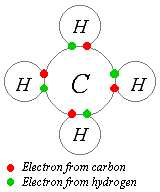Bonds and Electronegativity!
There are 3 main types of bonds in chemistry that we will study...
- Ionic (metal to non-metal)
- Electrons are transferred from metal to non-metal
2. Covalent (non-metal to non-metal)
- Holds pure metals together by electrostatic attraction...
So today in class, we learned about Electronegativity (en) which is a measure of an atom's attraction for electrons in a bond... for example
Fluorines electronegativity is 4.0, Chlorine is 3.0
Fluorines electronegativity is 4.0, Chlorine is 3.0
- Atoms with greater electronegativity attract electrons more!
- We learned about Polar Covalent bonds: Form from an unequal sharing of electrons, a polar covalent bond is a bond between two non-metals with different electronegativities. Unsymmetrical molecules are usually polar.
- Non-Polar covalent bonds form from equal sharing of electrons, and are symmetrical molecules.
The type of bond formed can be predicted by looking at the difference in electronegativity (en) of the elements *we were also given a periodic table of elements dealing with electronegativity*:
Let's try some examples shall we?
Predict the type of bond formed.
1. H- O
Electronegativity difference:
2.20
- 3.44
1.24
1.24 < 1.7
so we can conclude this bond between Hydrogen and Oxygen is a Polar Covalent bond!
Pretty easy right? Let's try one more and see how you do!
2. K-F
Electronegativity difference:
3.99
- 0.82
3.17
3.17 > 1.7
so we can conclude this bond between potassium and fluorine is an ionic bond!
We good? Try some on your own and the answers will be placed on the bottom! Goodluck!
Predict the type of bond formed.
a) O-O
b) F-Cl
c) Ba - I
d) O-Cl
e) Na-F
f) N-H
g) H-I
Answers:
*highlight to obtain answers!
a) Non-Polar covalent bond
b) Polar Covalent bond
c) Ionic bond
d) Polar covalent bond
e) Ionic bond
f) Polar covalent bond
g) Non-polar covalent bond
Post by Ren Ren Flores




No comments:
Post a Comment